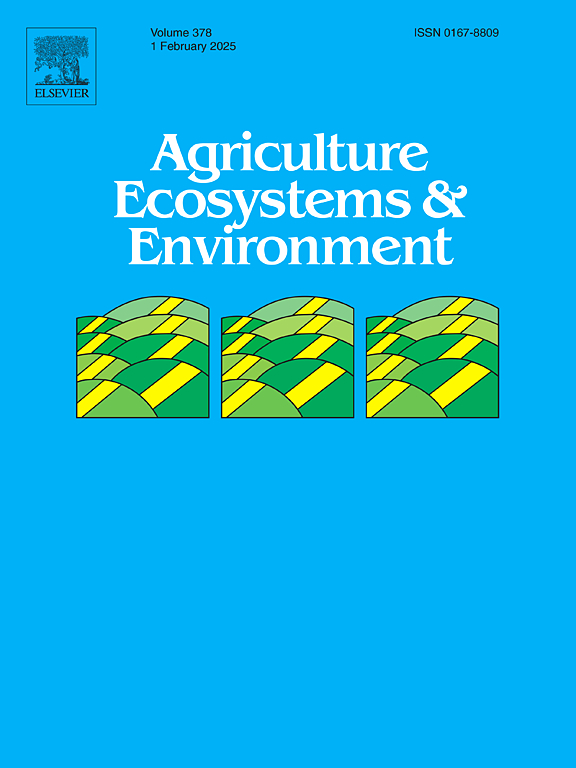通过比较产量、环境影响和经济效益,评价中国东南部多年生水稻的可持续发展潜力
IF 6
1区 农林科学
Q1 AGRICULTURE, MULTIDISCIPLINARY
引用次数: 0
摘要
多年生水稻(PR)种植系统是一种生态可持续和环境友好的种植方式,可提高资源效率,从而有可能取代中国东南地区传统的双季稻(DR)和再生稻(RR)系统。然而,目前还缺乏与PR相关的产量、碳氮足迹、经济效益和碳预算平衡的综合研究。本研究基于2022 - 2024年的田间试验,系统比较了PR、DR和RR种植系统在产量、直接温室气体(GHG)排放、碳氮足迹、净生态经济效益(NEEB)和净生态系统碳平衡(NECB)方面的表现。三年的研究结果表明,PR的年产量与DR和RR相当。然而,公关直接表现出显著减少温室气体排放,是21.7 % -25.91 %低于博士同样,公关的碳和氮足迹减少19.34 % % -25.87和7.12 % % -9.17,分别,而碳和氮足迹单位产量下降了16.76 % -28.02 % % 7.29 % -9.17。此外,与DR和RR相比,PR的年能量输入分别减少26.74% %和2.10 %。在经济效益方面,PR的NEEB比DR高83.24 %,比RR高10.85 %。PR组的NECB显著高于DR和RR组,分别增加15.77 % ~ 37.87 %和15.30 % ~ 43.45 %。这些优势主要归因于甲烷排放(CH4)、氨挥发(NH3)的减少和间接农业投入的减少。研究结果表明,尽管在为期三年的试验中,PR的产量与DR和RR相当,但其在碳和氮足迹、能源投入和经济效益方面的显著优势表明PR在中国东南部地区是一种非常有前途的可持续农业模式。它具有在减少资源投入和环境压力的同时保持高生产率的潜力。未来,进一步优化PR育种和栽培管理,可以在保持较低的能源投入和环境成本的同时,获得更高、更稳定的产量。本文章由计算机程序翻译,如有差异,请以英文原文为准。
Evaluating the sustainability potential of perennial rice in southeastern China by comparing yield, environmental impacts and economic benefits
The perennial rice (PR) cultivation system is an ecologically sustainable and environmentally-friendly approach that offers enhanced resource efficiency, thereby presenting the potential to supplant traditional double-cropping rice (DR) and ratoon rice (RR) systems in China's southeastern region. However, there is still a dearth of comprehensive studies examining the yield, carbon and nitrogen footprints, economic benefits, and carbon budget balance associated with PR. This study systematically compares the performance of PR, DR, and RR cultivation systems in terms of yield, direct greenhouse gas (GHG) emissions, carbon and nitrogen footprint, net ecological-economic benefits (NEEB), and net ecosystem carbon balance (NECB), based on field trials conducted from 2022 to 2024. The results from three years of research indicated that the annual yield of PR was comparable to that of DR and RR. However, PR exhibited a significant reduction in direct GHG emissions, which were 21.7 %–25.91 % lower than those of DR. Similarly, the carbon and nitrogen footprint of PR were reduced by 19.34 %–25.87 % and 7.12 %–9.17 %, respectively, while the carbon and nitrogen footprint per unit yield decreased by 16.76 %–28.02 % and 7.29 %–9.17 %. Additionally, the annual energy input of PR was reduced by 26.74 % and 2.10 % compared to DR and RR. In terms of economic benefits, the NEEB of PR was 83.24 % higher than that of DR and 10.85 % greater than that of RR. Furthermore, NECB of PR was significantly higher than that of DR and RR, with increases ranging from 15.77 % to 37.87 % and from 15.30 % to 43.45 %, respectively. These advantages were primarily attributed to reductions in methane emissions (CH4), ammonia volatilization (NH3), and lower indirect agricultural inputs. The findings suggest that despite the comparable yield of PR to that of DR and RR over the three-year trial, its significant advantages in terms of carbon and nitrogen footprints, energy input, and economic benefits indicate that PR represents a highly promising sustainable agricultural model for the southeastern region of China. It has the potential to maintain high productivity while reducing resource inputs and environmental pressures. In the future, further optimization of PR breeding and cultivation management may result in higher and more stable yields while maintaining low energy inputs and environmental costs.
求助全文
通过发布文献求助,成功后即可免费获取论文全文。
去求助
来源期刊

Agriculture, Ecosystems & Environment
环境科学-环境科学
CiteScore
11.70
自引率
9.10%
发文量
392
审稿时长
26 days
期刊介绍:
Agriculture, Ecosystems and Environment publishes scientific articles dealing with the interface between agroecosystems and the natural environment, specifically how agriculture influences the environment and how changes in that environment impact agroecosystems. Preference is given to papers from experimental and observational research at the field, system or landscape level, from studies that enhance our understanding of processes using data-based biophysical modelling, and papers that bridge scientific disciplines and integrate knowledge. All papers should be placed in an international or wide comparative context.
 求助内容:
求助内容: 应助结果提醒方式:
应助结果提醒方式:


